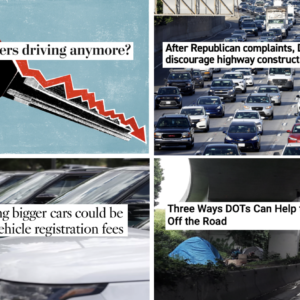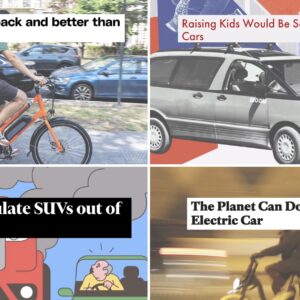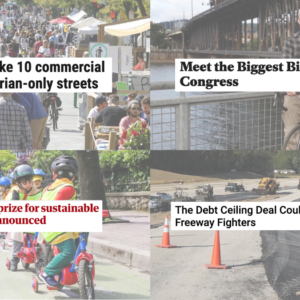Here are the great bike links from around the world that caught our eyes this week:
Racetrack gamble: As Minnesota’s only velodrome considers closing rather than putting up $850,000 for repairs, a private company is building a $100 million bike racing arena in Philadelphia.
Bike camping: You can now purchase a camper trailer for your bike. (Hope for low winds.)
DIY diverters: Rebel Metropolis has more good photos of the handpainted guerilla traffic diverters installed on Southeast Clinton last week by anonymous activists.
Seattle’s CRC: As Seattle’s deep-bore highway tunnel suffers its latest open-ended delay, Grist reviews Seattle’s disastrous attempt to build an underground highway along its shoreline.
Overestimating trips: The auto traffic projections that the bible of traffic engineering claims are associated with new developments appear to be way, way off and getting worse.
Bike lane renewal: Lincoln, Nebraska, is completing the funding for its new downtown protected bike lane (designed by two Portland companies) with urban renewal funds.
Bike lane removal: Newark, New Jersey, is ripping out its first protected bike lane in part because it’s stopping people from double-parking while they shop.
“Magic roundabout”: OK, the new North Williams might be confusing, but it could be worse.
Advertisement
Assigning blame: In its podcast, Strong Towns asks whether individual engineers should be held at fault when people are killed on streets they design.
Self-parking cars: BMW’s new “remote valet parking” system can navigate a multistory parking lot without you in it.
Gamifying riding: Cycling app KappoBike is like Strava except more game-like, and it’s building the sale of biking data to cities right into its business model.
Bike lane record: Washington D.C. added a record nine miles of new bike lanes in 2014. (Portland has hit that mark six times: in 1981 and every year from 1995-1999.)
Bike lane honored: The PeopleForBikes Green Lane Project named SW Multnomah Boulevard the country’s seventh best new bike lane of the year. (Disclosure: I wrote this article for my other job, but as always when we link to PFB stories in the Roundup, Jonathan chose it.)
Pricing parking: Part of downtown DC is experimenting with parking prices that vary by time of day, plus a few times a year, to respond to driver demand.
California laws: The California Bicycle Coalition’s ambitious legislative agenda includes an official definition for low-speed e-bikes and special ticket diversion programs for people who get citations while biking.
Mandatory helmets: As the Canadian province of Newfoundland and Labrador prepares to enact a new mandatory bike helmet law, one woman predicts that the main effect will be lower biking rates — which are, of course, hazardous to one’s health.
Mobile green space: Who needs to bike to the park when the park bikes to you?
And your video of the week looks at a low-car city that could — at least for the moment — become a new model for livable American streets:
The Street Life of Havana from STREETFILMS on Vimeo.
If you come across a noteworthy bicycle story, send it in via email, Tweet @bikeportland, or whatever else and we’ll consider adding it to next Monday’s roundup.






Thanks for reading.
BikePortland has served this community with independent community journalism since 2005. We rely on subscriptions from readers like you to survive. Your financial support is vital in keeping this valuable resource alive and well.
Please subscribe today to strengthen and expand our work.
I’ve been to Newfoundland several times, for work — twice this year — and my anecdotal observation is that bikes are very rare there, even at Memorial University. (Maybe because they don’t fit in the tunnels that connect all the buildings.) There is nice network of foot trails in St. John’s, though.
I don’t know about Labrador…
The effects of mandatory helmet laws are pretty clear cut – the numbers are pretty static regardless of what country they implemented in.
It will reduce the number of cyclists on the road by roughly 40%. For those under the age of 18, closer to 60%.
on assigning blame… I keep wondering when the contractor ODOT hired, that re-paved only half the shoulders on Hwy 101 and much of the rest of the state, apparently, will pick up the tab for redoing it?
Regarding New Jersey:
“The crux of the argument to remove the bike lanes was that they had eliminated valuable parking that was preventing customers from visiting the stores on the avenue.”
*sigh* We all know the answer to this. Bicyclists spend more at local restaurants and bars. Here’s the link to the study.
http://tinyurl.com/qgzkzme
Newark, thank you for continuing to be such a paragon of pleasant living. People will continue to praise your pleasant urban environment for decades to come.
The insane thing in that story is that the “removed parking” was double-parking! The roadway was so wide, that there was a de-facto double-parking area. So those businesses were literally complaining because their customers couldn’t break the law anymore.
Nick, I live in NJ and wrote the article. NJ just doesn’t “get” cycling no matter how much cool stuff gets built just over the rivers in NYC and Philly. I’m also a bike / ped planner and see absolutely no career future here. Such a shame because Jersey truly has the potential to be the most bicycle friendly state due to the great Pre-War infrastructure we inherited.
That whole Washington DC – PDX bike lane record? How well has PDX done recently in the new lane dept?
Yeah, not well at all – the “six times” wasn’t meant as a boast.
that roundabout can’t be real
Swindon?
(Looks)
Swindon. It’s real.
And safer than any large intersection in the U.S.
Not exactly ‘news’ either; it’s been there for over 40 years.
Swindon is one of a half-dozen ring junctions. The are former large diameter rotarys that were converted to two-way operation and the intersecting streets turned into mini-roundabouts. In the case of Swindon, the rotary was just smaller than usual.
Other locations:
Colchester UK (2)
Denham UK
Hatton Cross UK
Hemel Hempstead UK (2)
High Wycombe UK
Tamworth UK
Defining *low speed* e-bikes is a great idea. I’d set an absolute maximum assist to 20MPH. It is a more or less “human” speed at the threshold for rarely fatal collisions. Seems like fair limit to what you can do with a motor, but without a license and insurance.
I read $75k for the Minnesota velodrome. If that’s an order of magnitude off, then the NSC velodrome definitely isn’t worth it. This is an open air facility in a distant suburb that’s unusable for half the year. Just imagine a rush hour drive all the way across the metro for Thursday night races, only to get rained out. However long it takes, they need a covered track in a central city.
Maximum *assisted* speed. That’s good enough to win almost every uphill “Cat 6” race, and there’s nothing to stop you from going faster the old fashioned way anywhere else.
Well, maybe that you’re pushing a 50 pound bike.
I’d rather see all that money go to a pro woman’s racing team where it’s needed.
Sorry, “women’s”… there’s no ‘I’ in team. 😉
it’s my understanding that the 20 mph fatality speed is for collisions with motor vehicles, not with things that have a MUCH smaller mass such as bicycles…
The $75k figure is accurate. bikeportland is off by 10x.
If we’re wrong, so is the Associated Press. Which is possible, of course. The article linked there includes two numbers: one $60,000 estimate for keeping it working for a few years (which is what local folks are fundraising for) and one $850,000 for “a renovation,” which I assume means something more intensive and longer-term.
Nomad Cargo in SE is doing the camper trailer with more of a social justice mission: building homeless community members a trailer that helps them get around the camping ban by being inside a private vehicle.
Only one prototype now but Kevin would be an awesome person to interview for an article sometime.
The video of Havana is (IMO) one of Streetfilms’ best! It does a great job of highlighting the “living laboratory” opportunity that only Havana’s unique and isolated recent history could make possible. Where else in the world did Motordom get started in the 50s and then abruptly halt?
I’m sure the filmmakers cherry-picked the images (they more or less admit this), but still, so many scenes of vibrant, low-car and no-car street life! Very inspiring.
That deep bore tunnel in Seattle is such a mess. For what it’s going to end up costing to finish (if they even can finish it), they could have built a second light rail line from West Seattle to Fremont and Ballard, with a tunnel under downtown. Then they could have torn down the viaduct and opened up tons of space on the waterfront for development or a park of some kind.
It seems like Seattle loves to do things in an expensive, misguided fashion.
I wonder if Seattle’s engineering-heavy population in some way contributes to that mindset?
Just thinking out loud…
It has more to do with corruption-heavy local government than engineering-heavy population, by far.
Citations please.
Go cry to your mother, sad little kowtower to the status quo.
Re. the editorial on bike helmets not being effective or maybe even deleterious… my rebuttal:
1.The writer (a mother in Scotland, I believe) seems to conflate head injuries with other (non head) injuries. Clearly a helmet will not protect against a fractured spine, spleen or pelvis, so claiming that injury rates (all types) have gone up in some places after helmet law adoption seems like a straw man argument to me. Unless you somehow believe that a helmet makes a person more prone to being involved in a crash. I’ll leave it up to you to figure out why or how that might be.
2. She writes “I looked into the research and came to the conclusion that helmets do little or nothing to protect cyclists from harm.” My cursory review of the literature tells me otherwise. Here’s a nice summary of the data with citations at the bottom: http://bulletin.facs.org/2014/09/statement-on-bicycle-safety-and-the-promotion-of-bicycle-helmet-use/
3. Of course a helmet won’t help your brain (much) from a direct impact with a moving vehicle. That was never the intention. Most cyclists fall from the sitting position on the bike to the ground and strike their head on the pavement, a bout a three-four foot drop. That’s how most head injuries occur, and how a helmet can protect. Getting hit in the head by an oncoming vehicle ain’t gonna end well no matter what you’re wearing on your head. Laws of physics, and all that…
4. Whether or not a helmet should be mandatory – that’s a political and economic question, and I’m not going to argue either way (at least not here). But I do believe that the preponderance of the data shows that a bike helmet does protect or minimize traumatic brain injury in most situations.
When Western Australia introduced mandatory helmet wearing, all hospital visit injuries fell. which indicated that, since helmets don’t protect collar bones, cycling rates fell. Curiously, head injuries fell less than did non-head injuries, which implies that the remaining cyclists were more likely to suffer head injuries.
Regarding, “Most cyclists fall from the sitting position on the bike to the ground and strike their head on the pavement, a bout a three-four foot drop. That’s how most head injuries occur, and how a helmet can protect.” What is your evidence for this? If that is the case, then it is unlikely that helmets will reduce fatalities, since, in the UK at least, most head injury fatalities are caused by collisions with motor vehicles.
The latter were investigated some years ago by Dr. Mayer Hilman. He looked at all injuries suffered by riders who died from head injuries and found that about 92% of them would have died even without the head injury.
Many of the anecdotal stories about helmet wearing having saved a life may be true or they may not be, no matter how convinced the wearer is. Hainv been rendered partially unconscious in a collision with a gormless pedestrian who was crossing against the lights, my first response was along those lines, especially as the helmet was cracked through. However, the crack was at the rear left hand part which prjected further out than the side of the helmet. It is entirely possible that my head would not have hit the ground. I have no way of knowing.
great fact, Atbman, but what is gormless?
A way of telling who incorporates idiom from Harry Potter into their writing.
http://www.merriam-webster.com/dictionary/gormless
actually this is a better source
http://dictionary.reference.com/browse/gormless?s=t
““Most cyclists fall from the sitting position on the bike to the ground and strike their head on the pavement, a bout a three-four foot drop. That’s how most head injuries occur, and how a helmet can protect.” What is your evidence for this? If that is the case, then it is unlikely that helmets will reduce fatalities, since, in the UK at least, most head injury fatalities are caused by collisions with motor vehicles.”
Evidence: NTDB (National Trauma Data Bank).
Shows that of serious head injuries sustained while riding a bike, those that involve fall off the bike, not the head actually hitting another vehicle or a tree, etc, are the most common. A bit stronger evidence that what you label as anecdotal, I’m afraid.
BTW, the finding that “in the UK at least, most head injury fatalities are caused by collisions with motor vehicles” is certainly no logical reason to claim that helmets are of no benefit. If they reduce injury and fatality from less-common mechanisms, they are still beneficial.
Reading comments in that PFB article about bike lanes is PAINFUL! There’s nothing I hate worse than bicyclists arguing about which type of infrastructure is ‘better’ than another. Different treatments for different goals, people, and despite the way things *should* be here in the US, we are still fighting for table scraps.